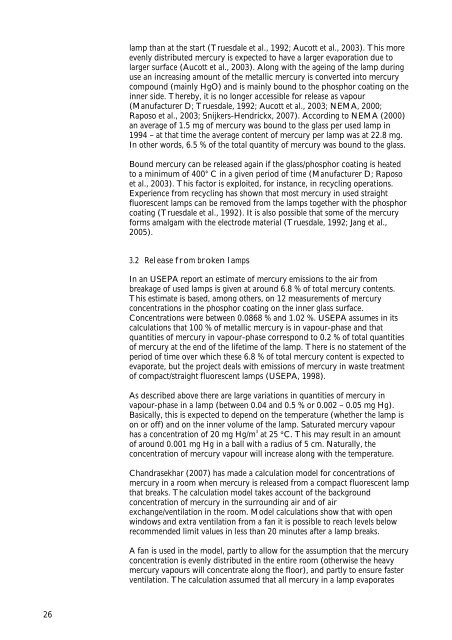No. 104 - Miljøstyrelsen
No. 104 - Miljøstyrelsen
No. 104 - Miljøstyrelsen
You also want an ePaper? Increase the reach of your titles
YUMPU automatically turns print PDFs into web optimized ePapers that Google loves.
26<br />
lamp than at the start (Truesdale et al., 1992; Aucott et al., 2003). This more<br />
evenly distributed mercury is expected to have a larger evaporation due to<br />
larger surface (Aucott et al., 2003). Along with the ageing of the lamp during<br />
use an increasing amount of the metallic mercury is converted into mercury<br />
compound (mainly HgO) and is mainly bound to the phosphor coating on the<br />
inner side. Thereby, it is no longer accessible for release as vapour<br />
(Manufacturer D; Truesdale, 1992; Aucott et al., 2003; NEMA, 2000;<br />
Raposo et al., 2003; Snijkers-Hendrickx, 2007). According to NEMA (2000)<br />
an average of 1.5 mg of mercury was bound to the glass per used lamp in<br />
1994 – at that time the average content of mercury per lamp was at 22.8 mg.<br />
In other words, 6.5 % of the total quantity of mercury was bound to the glass.<br />
Bound mercury can be released again if the glass/phosphor coating is heated<br />
to a minimum of 400° C in a given period of time (Manufacturer D; Raposo<br />
et al., 2003). This factor is exploited, for instance, in recycling operations.<br />
Experience from recycling has shown that most mercury in used straight<br />
fluorescent lamps can be removed from the lamps together with the phosphor<br />
coating (Truesdale et al., 1992). It is also possible that some of the mercury<br />
forms amalgam with the electrode material (Truesdale, 1992; Jang et al.,<br />
2005).<br />
3.2 Release from broken lamps<br />
In an USEPA report an estimate of mercury emissions to the air from<br />
breakage of used lamps is given at around 6.8 % of total mercury contents.<br />
This estimate is based, among others, on 12 measurements of mercury<br />
concentrations in the phosphor coating on the inner glass surface.<br />
Concentrations were between 0.0868 % and 1.02 %. USEPA assumes in its<br />
calculations that 100 % of metallic mercury is in vapour-phase and that<br />
quantities of mercury in vapour-phase correspond to 0.2 % of total quantities<br />
of mercury at the end of the lifetime of the lamp. There is no statement of the<br />
period of time over which these 6.8 % of total mercury content is expected to<br />
evaporate, but the project deals with emissions of mercury in waste treatment<br />
of compact/straight fluorescent lamps (USEPA, 1998).<br />
As described above there are large variations in quantities of mercury in<br />
vapour-phase in a lamp (between 0.04 and 0.5 % or 0.002 – 0.05 mg Hg).<br />
Basically, this is expected to depend on the temperature (whether the lamp is<br />
on or off) and on the inner volume of the lamp. Saturated mercury vapour<br />
has a concentration of 20 mg Hg/m 3<br />
at 25 °C. This may result in an amount<br />
of around 0.001 mg Hg in a ball with a radius of 5 cm. Naturally, the<br />
concentration of mercury vapour will increase along with the temperature.<br />
Chandrasekhar (2007) has made a calculation model for concentrations of<br />
mercury in a room when mercury is released from a compact fluorescent lamp<br />
that breaks. The calculation model takes account of the background<br />
concentration of mercury in the surrounding air and of air<br />
exchange/ventilation in the room. Model calculations show that with open<br />
windows and extra ventilation from a fan it is possible to reach levels below<br />
recommended limit values in less than 20 minutes after a lamp breaks.<br />
A fan is used in the model, partly to allow for the assumption that the mercury<br />
concentration is evenly distributed in the entire room (otherwise the heavy<br />
mercury vapours will concentrate along the floor), and partly to ensure faster<br />
ventilation. The calculation assumed that all mercury in a lamp evaporates

















